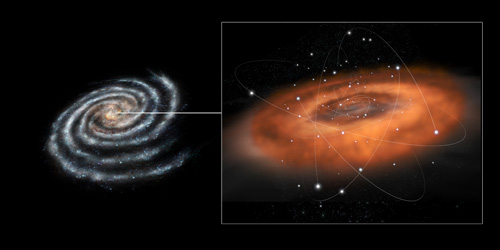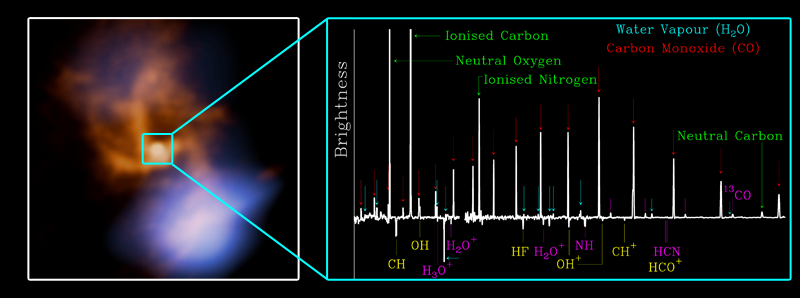| Basic Information | |
| What is this? | The region around the supermassive black hole at the centre of our Galaxy |
| Where is it in the sky? | In the constellation of Sagittarius |
| How big is it? | The black hole is 6 million times as massive as our Sun |
| How far away is it? | 26,000 light years away, in the very centre of our Milky Way galaxy |
| What do the colours represent? | Blue shows gas in a ring around the black hole around 10 light years across, while the orange regions are a mini-spiral of gas falling towards the black hole |
Downloads
See this object in:

Astronomers using Herschel have spotted a cloud of incredibly hot gas very close to the supermassive black hole that lies at the heart of our Milky Way galaxy.
The supermassive black hole goes by the name of Sagittarius A*, and weighs in at 4 million times the mass of our Sun. It is nearly 30,000 light years away at the very centre of our galaxy, but is still hundreds of times closer than other such black holes, which are usually found at the centres of large galaxies.
Its relative proximity makes it the ideal target for studying these extreme environments in detail, though our view is often obscured by dense clouds of dust draped throughout the Milky Way. By studying it in far-infrared light, Herschel can see through this dust and examine the surroundings of the black hole itself. The black hole is surrounded by a ring of gas around 30 light years across, but right in the centre is a mini spiral of gas flowing inwards.
Herschel observations taken in 2011 and 2012 allowed astronomers to examine the region within around a light year of the black hole itself. The data showed the presence of elements such as carbon, nitrogen and oxygen, as well as simple molecules including water, carbon monoxide and hydrogen cyanide.

“Herschel has resolved the far-infrared emission within just 1 light-year of the black hole, making it possible for the first time at these wavelengths to separate emission due to the central cavity from that of the surrounding dense molecular disc,” says Javier Goicoechea of the Centro de Astrobiología, Spain, who led this particular study.
Herschel showed that some of the material in the inner spiral is moving incredibly quickly, at speeds of over 300 km/s (1 million km per hour), and must be very close to the black hole itself – possibly on the verge of falling in. “The observations are consistent with streamers of hot gas speeding towards Sgr A*, falling towards the very centre of the Galaxy,” says Dr Goicoechea. “Our Galaxy’s black hole may be cooking its dinner right in front of Herschel’s eyes.”
But what really took astronomers by surprise was the temperature of the gas, reaching temperatures of 1000 Celsius in places – much hotter than most interstellar material which is at temperatures of −200 Celsius or below.
Some of the heating is due to intense light from nearby stars, as well as from very hot material very close to the black hole itself, but the team has calculated that this can only account for a relatively small temperature increase. The most likely cause is that intense shockwaves and turbulence, possibly due to fast-moving gas from young stars, causes heat up the material as it is thrown around.
This research used data from the spectrometers that are part of Herschel’s SPIRE and PACS instruments. “These instruments can identify the emission from specific types of atoms and molecules out in space,” explained Edward Polehampton, of the Rutherford Appleton Laboratory, and a member of the SPIRE spectrometer team. “Such detailed analysis has only been possible thanks to Herschel being in space, well away from the obscuring effects of the Earth’s atmosphere”.
Herschel finished its scientific observations in April 2013, when its supply of liquid helium coolant was exhausted. “This is a fascinating study with Herschel of what goes on right at the centres of galaxies. Even though Herschel has now finished observing, there’s still a huge amount of work to be done,” commented Matt Griffin, of Cardiff University and lead scientist of the SPIRE instrument. “Over the next few years, as we process the full archive of Herschel data, we know there will be many more results like this”.

